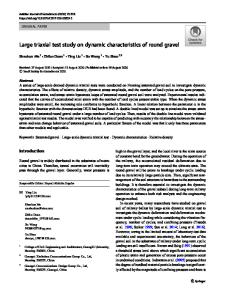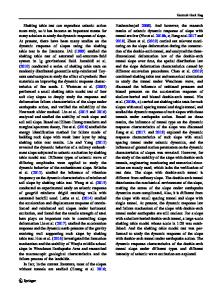Experimental study on dynamic characteristics and dynamic responses of accumulation slopes under frequent microseisms
- PDF / 1,173,612 Bytes
- 11 Pages / 595.276 x 790.866 pts Page_size
- 96 Downloads / 366 Views
ORIGINAL PAPER
Experimental study on dynamic characteristics and dynamic responses of accumulation slopes under frequent microseisms Zhongping Yang 1,2 & Xin Tian 2 & Yuanwen Jiang 2 & Xinrong Liu 1,2 & Yuanxin Hu 3 & Yunliang Lai 2 Received: 2 August 2019 / Accepted: 29 July 2020 # Saudi Society for Geosciences 2020
Abstract Accumulation slopes are extensively distributed in the Three Gorges Reservoir area, China. The seasonal variation of reservoir’s water level will induce high-frequency microseisms, which may cause landslides in reservoir banks. The study of the dynamic responses of the slope under earthquakes is the basis of the dynamic stability analysis of the slope. This paper studies the dynamic characteristics and dynamic responses of accumulation slopes under frequent microseisms by shaking table tests. Different moisture contents and dens degrees are treated as the key research contents, and a total of nine slope models have been carried out for experimental studies. The results show that the acceleration responses of the slopes under different working condition exhibit obvious “altitude effect”. The dynamic characteristics refer chiefly to the inherent properties of the model, containing damping ratio and natural frequency, and the change of the latter is more sensitive. With the increasing of water content of the model, the decrease of the natural frequency is less, and the dynamic response shows a linear growth trend. The amplitude of the reduction of the natural frequency decreases with the increase of the dens degree. The results reveal the instability mechanism of the accumulation slopes under frequent microseisms and provide reference for the seismic design of the slope engineering. Keywords Frequent microseisms . Accumulation slopes . Dynamic characteristics . Dynamic responses
Introduction Earthquakes, as one of the most severe natural calamities in the mountainous areas, have unexpectedly caused a large number of slope stability problems, especially earthquakeinduced secondary disasters, which result in massive human casualties and economic losses (Gorum et al. 2011; Tanoli et al. 2017). The Ms8.0-magnitude earthquake, happened at Wenchuan on May 12, 2008, has triggered more than 15,000
geological disasters such as landslides, collapses, and mudslides (Huang and Li 2009; Cui et al. 2011; Li et al. 2018), which directly caused 20,000 deaths (Yin 2008; Wang et al. 2014). After the earthquake, the large number of accumulation slopes caused by collapses and landslides have low safety margin. Once the stability condition is destroyed, it will bring great disaster threat to local residents. In 1985, an extremely large accumulation landslide with a volume of about 30 million cubic meters of earth and rock occurred in
Responsible Editor: Zeynal Abiddin Erguler * Zhongping Yang [email protected] Xin Tian [email protected]
Yunliang Lai [email protected] 1
Ministry of Education, Key Laboratory of New Technology for Construction of Cities in Mountain Area, Chongqing University, Chongqing 400030, Chin
Data Loading...











